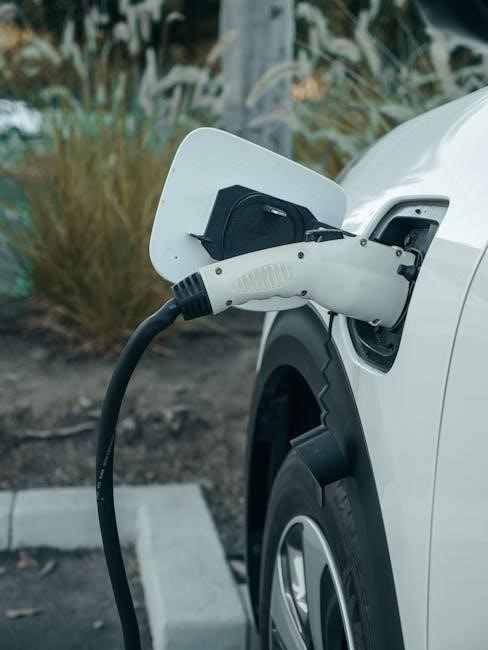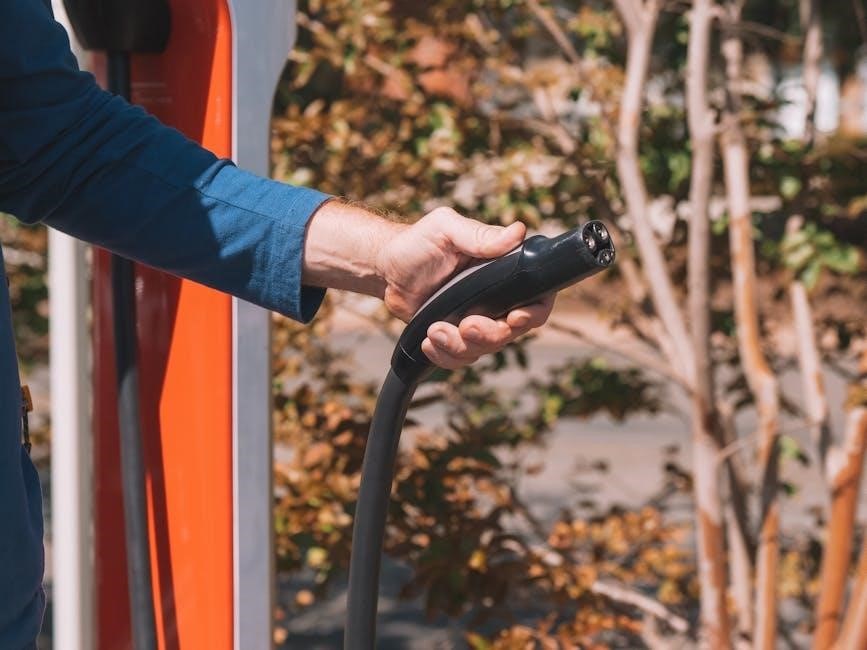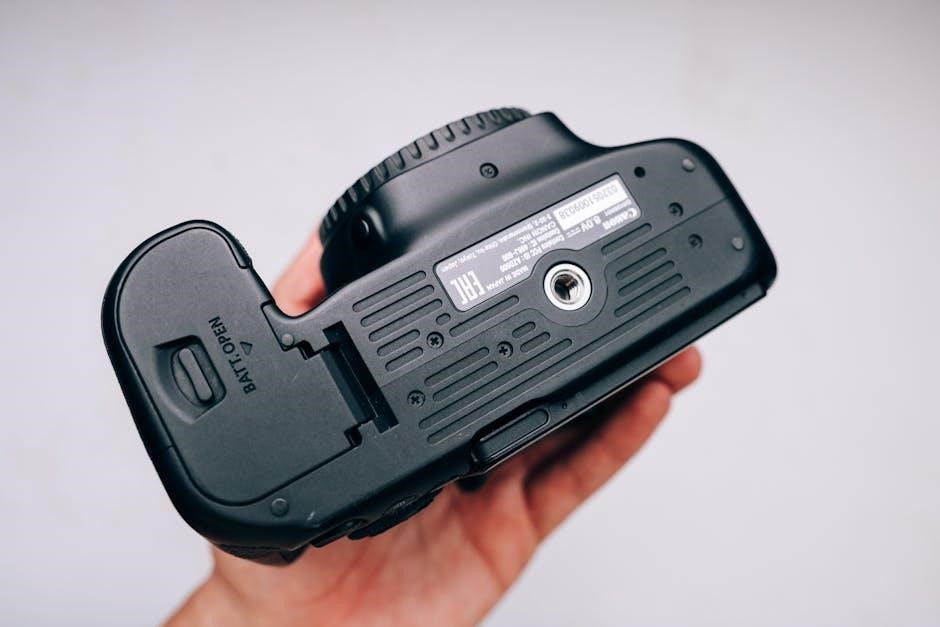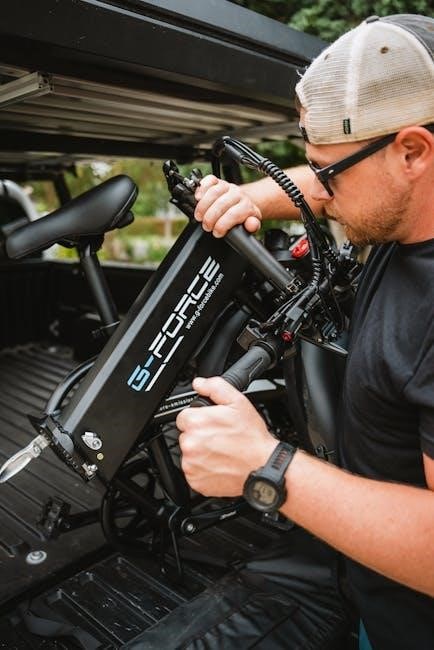Manual battery chargers provide direct current for electrolysis‚ a process requiring consistent voltage‚ and can be used effectively with a charger output of at least 12 volts‚ making them suitable for electrolysis applications‚ including rust removal and cleaning․
Definition and Purpose of Manual Battery Chargers
A manual battery charger is a device that allows operators to manually adjust current and voltage without automated features‚ making it a suitable option for electrolysis applications; The purpose of a manual battery charger is to provide a direct current (DC) power supply‚ which is necessary for electrolysis to occur․ In the context of electrolysis‚ a manual battery charger is used to supply the consistent voltage needed for the process to take place․ The charger output should be at least 12 volts to be effective․ Manual battery chargers are often preferred for electrolysis because they allow for more control over the charging process․ They are also relatively simple and inexpensive compared to smart chargers․ Overall‚ the definition and purpose of manual battery chargers make them a popular choice for electrolysis applications‚ including rust removal and cleaning․ The use of manual battery chargers has been effective in various contexts‚ and their simplicity and affordability make them a viable option for those looking to use electrolysis․ Manual battery chargers can be used with various types of electrolysis machines․

Principle of Electrolysis Using a Manual Battery Charger
Electrolysis occurs through direct current from a manual battery charger‚ separating compounds with consistent voltage and current‚ facilitating chemical reactions and transformations‚ using electrolysis principles effectively․
Basic Requirements for a Manual Battery Charger
A manual battery charger for electrolysis requires a direct current output‚ typically with a voltage of at least 12 volts‚ to facilitate the electrolysis process․ The charger should have a manual mode to allow for adjustment of current and voltage‚ as automatic modes may not be suitable for electrolysis․ A charger with a high current output is also desirable‚ as it can increase the efficiency of the electrolysis process․ Additionally‚ the charger should be designed for DC power supply‚ as electrolysis uses direct current․ Most car battery chargers meet these requirements‚ making them a suitable option for electrolysis․ The charger’s output should be consistent and stable‚ to ensure a safe and effective electrolysis process․ It is also important to consider the charger’s power rating and ensure it can handle the required current and voltage for the electrolysis application․ Overall‚ a manual battery charger with the right specifications can provide a reliable and efficient power source for electrolysis․ The key is to select a charger that meets the basic requirements for electrolysis‚ including direct current output and manual mode․

Advantages of Using a Manual Battery Charger for Electrolysis
Manual battery chargers offer simplicity and cost-effectiveness for electrolysis‚ providing a consistent voltage and current‚ making them a suitable option for various electrolysis applications and uses‚ including cleaning and rust removal processes easily․
Comparison with Smart Chargers
Manual battery chargers differ from smart chargers in their ability to manually adjust current and voltage without automated features‚ making them more suitable for electrolysis applications where consistent voltage is crucial․
Smart chargers‚ on the other hand‚ can significantly enhance the safety and lifespan of battery systems in electrolysis applications‚ as research has shown․
However‚ smart chargers may not be compatible with electrolysis tanks‚ as they can detect the tank as a short circuit and refuse to supply power‚ whereas manual chargers can be used in manual mode to bypass this issue․
In contrast‚ manual battery chargers offer a more straightforward and cost-effective solution for electrolysis‚ without the need for advanced automated features‚ making them a popular choice for those looking to get started with electrolysis․
Overall‚ the choice between a manual battery charger and a smart charger depends on the specific needs and requirements of the electrolysis application‚ with manual chargers offering a simple and effective solution for those who require consistent voltage and current․

Setting Up a Manual Battery Charger for Electrolysis
Setting up a manual charger requires selecting a charger with a suitable output and connecting it to the electrolysis machine‚ ensuring proper voltage and current for effective electrolysis‚ using a DC power supply․
Key Considerations for Effective Electrolysis
To achieve effective electrolysis using a manual battery charger‚ several key considerations must be taken into account․ The charger’s output voltage and current must be suitable for the specific electrolysis application‚ and the charger should be set to manual mode to avoid automatic shut-off․ Additionally‚ the electrolysis machine’s design and configuration play a crucial role in determining the effectiveness of the process․ The type and concentration of the electrolyte‚ as well as the surface area and material of the electrodes‚ can significantly impact the efficiency of the electrolysis reaction․ Furthermore‚ factors such as temperature‚ pressure‚ and pH levels can also influence the outcome of the process․ By carefully considering and optimizing these factors‚ users can maximize the effectiveness of their manual battery charger-powered electrolysis system and achieve the desired results․ Proper maintenance and safety precautions are also essential to ensure safe and successful operation․

Applications of Manual Battery Chargers in Electrolysis
Manual battery chargers are used in rust removal‚ cleaning‚ and restoration of metal items‚ such as cast iron skillets and griddles‚ using electrolysis effectively always with direct current power supply․
Examples of Successful Electrolysis Using Manual Battery Chargers
There are several examples of successful electrolysis using manual battery chargers‚ including the restoration of cast iron items such as skillets and griddles․ Many individuals have reported using manual battery chargers to effectively remove rust and clean metal items․ For instance‚ a person used a manual battery charger to power an electrolysis machine and successfully removed rust from a large cast iron skillet․ Another example is the use of a manual battery charger to clean a rusty old griddle‚ which was restored to its original condition after several hours of electrolysis․ These examples demonstrate the effectiveness of manual battery chargers in electrolysis applications‚ and highlight the potential for individuals to use this technology to restore and clean metal items․ The use of manual battery chargers for electrolysis has been shown to be a cost-effective and efficient method for removing rust and cleaning metal surfaces‚ and has been used successfully in a variety of applications․


